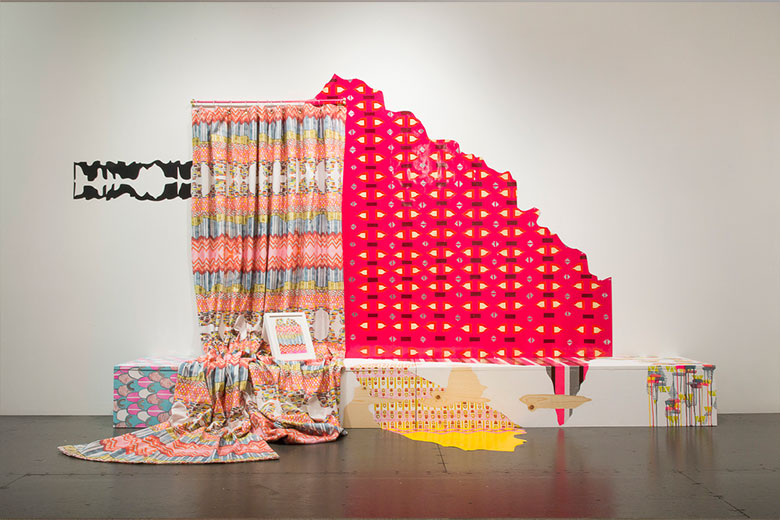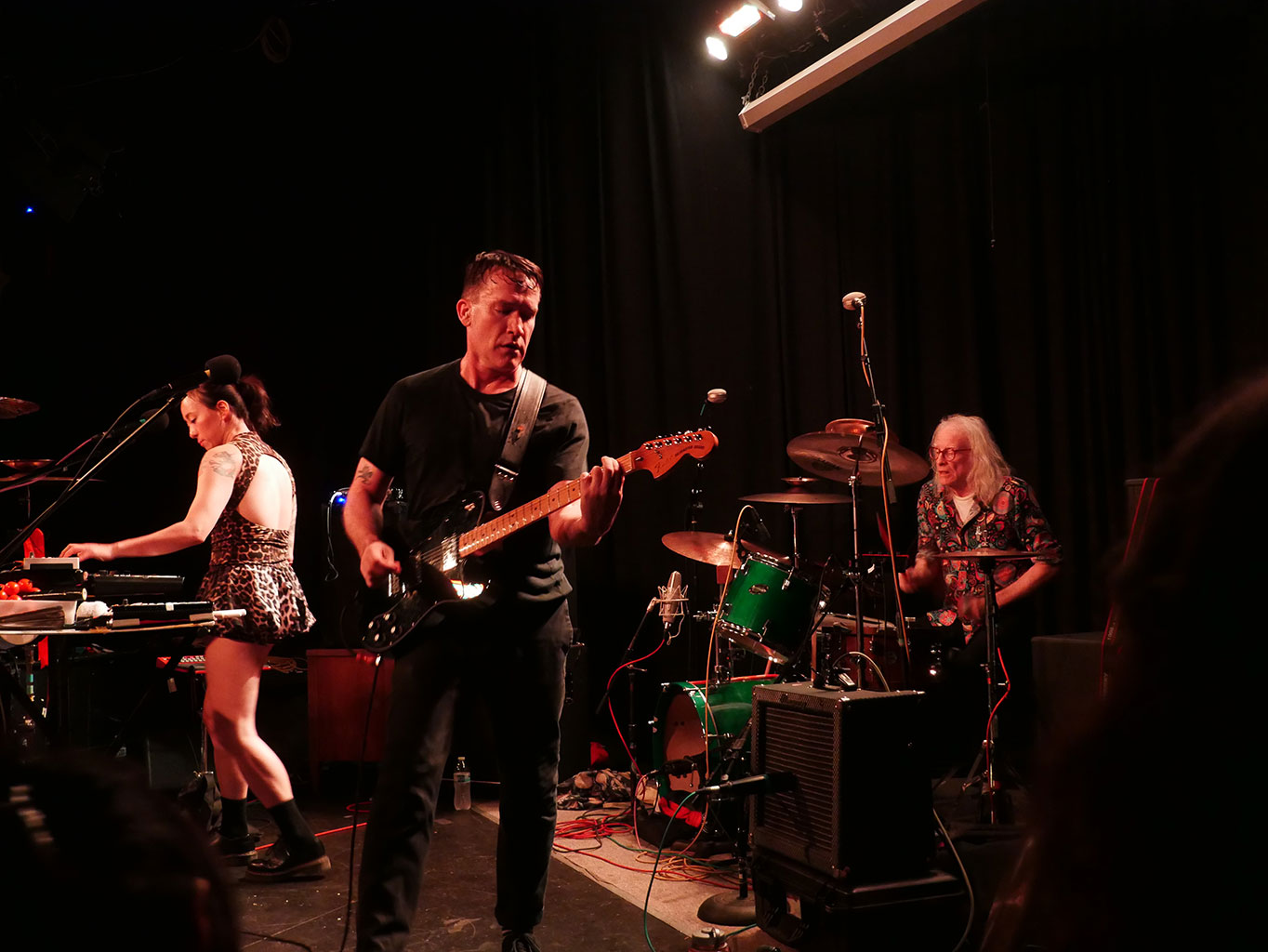Discovery.
Freedom of form, in intuition…

 Backdrop at MadArt, 2015 – Photography by James Harnois
Backdrop at MadArt, 2015 – Photography by James Harnois
 Seattle artist Julie Alpert speaks in the language of colorful flourish. Utilizing a brilliant slew of found objects and textural materials to evoke a hard-to-pinpoint sense of nostalgia, her work unravels on gallery walls like word associations mined from subconscious minds. Site-specific, certainly, but “site-transformative” may be just as strong a term. Far from passive, Alpert uses art to make bold statements, and employs a combination of spontaneous and planned processes to actively encourage viewers to reevaluate their relationship to white wall installs.
Seattle artist Julie Alpert speaks in the language of colorful flourish. Utilizing a brilliant slew of found objects and textural materials to evoke a hard-to-pinpoint sense of nostalgia, her work unravels on gallery walls like word associations mined from subconscious minds. Site-specific, certainly, but “site-transformative” may be just as strong a term. Far from passive, Alpert uses art to make bold statements, and employs a combination of spontaneous and planned processes to actively encourage viewers to reevaluate their relationship to white wall installs.
Art as an Anti-Analytical Action
Alpert’s artistic path has always been a bit of a winding road, naturally snaking in and out of varied creative interests at different times of her life. Early on, Alpert was much informed by theatre, only to leave it behind as she sought an undergraduate degree in Painting from the University of Maryland. It was in college that she first began paving the roads towards her present work, initially by “tinkering with installation and things that were dealing with frames and paintings as objects extending off the wall.”
But then Alpert decided to step back, taking a five-year break where she hardly made anything. When she finally decided to return to graduate school, she discovered that many of her previous artistic preconceptions were lost. She was essentially starting over from scratch — and in the empty wake of endless possibility, one of the first significant issues she faced was that of overthinking her creative process.
“By the second quarter [of graduate school], I just sort of [realized]… all of this thinking is not really getting me anywhere, so I started to just doodle and collect things…” Alpert recalls. She explains that her first installation in graduate school was made entirely from paint from the hardware store and objects she found discarded in the hallways of the studios.
“Once I just started working in a responsive way, as opposed to in an analytical way — that’s when I started to feel that the work was becoming something, and that it was about something, although I didn’t exactly know what it was about,” she adds. “Of course, we’re always still trying to figure that out. And it is always changing, right?”
Time and time again, Alpert professes herself to be “extremely analytical” and admits that she might even be “slightly neurotic”. The evolution of her process, then, seems a direct response to the standard reign of her logical mind.
“I’m making this work to try and turn that off,” says a very candid Alpert. “It’s extremely calming to make, and I also think that I also make better work when I turn off those voices.”
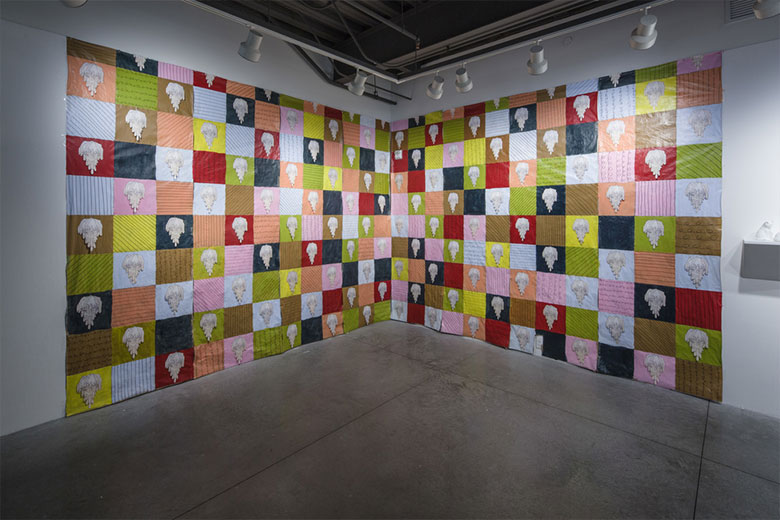 Collaborative student work at Clark College and Alpert’s installation, Splat! 2015 – Photography by Dan Kvitka
Collaborative student work at Clark College and Alpert’s installation, Splat! 2015 – Photography by Dan Kvitka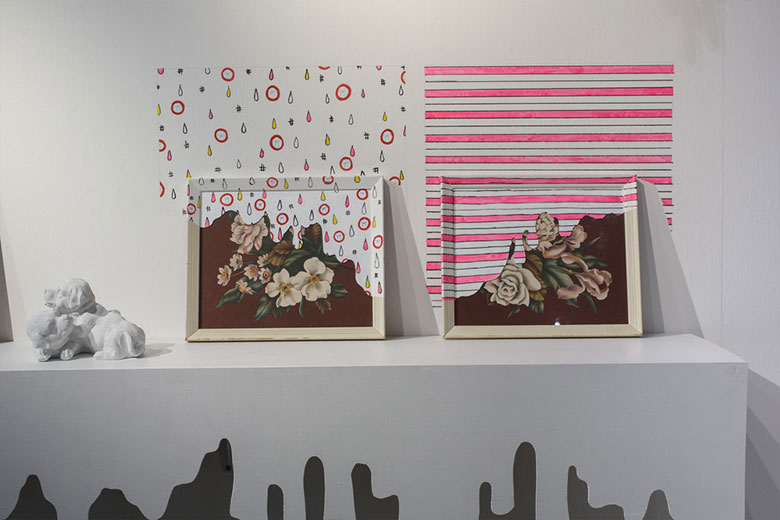

Alpert’s gallery installations are very much a “see what sticks” scenario. Though she may not be literally throwing things at the wall, she always leaves ample room for experimentation and customization within every space.
“I usually prepare about 50% and then do the other 50% [on-site],” she reveals. “I have the major elements figured out, but I just bring a big tub of things. If there’s something I absolutely need that I didn’t bring, then I just go on Amazon and overnight it.”
At Look-Alikes, her 2014 show at Seattle’s SOIL Gallery, Alpert relied on her go-to materials — house paint, acrylic, markers, tape, vinyl, and cardboard — to create a very distorted bedroom scene, full of illustrated lamps and ladder outlines that melted onto a wall exploding with strawberry reds. Perhaps it was due to the familiar nature of the household objects she manipulated, but the reactions Alpert received were humorously reflective of how polarizing her work can be.
“One of the SOIL members said to me during the critique that it made him feel really uneasy,” she recalls, amused. “[Other] people were saying, ‘Oh, I want to move into that space’… and this guy said, ‘This makes me feel really uncomfortable.'”
In recent years, Alpert has begun incorporating complex patterns into her works, which include everything from stripes, dots, and floral motifs to repeating custom elements, which she then tiles like wallpaper. The method to Alpert’s madness may only be evident to those who reside in similar states of mind — but beneath such busy façades are a number of malleable “guidelines”, which do in fact inform her works.
“I certainly have patterns and systems that I use, and I have a cache in my mind of certain shapes that follow other shapes — but I’m totally working intuitively,” she stresses again. “I’m trying really hard to let my brain not get involved.”
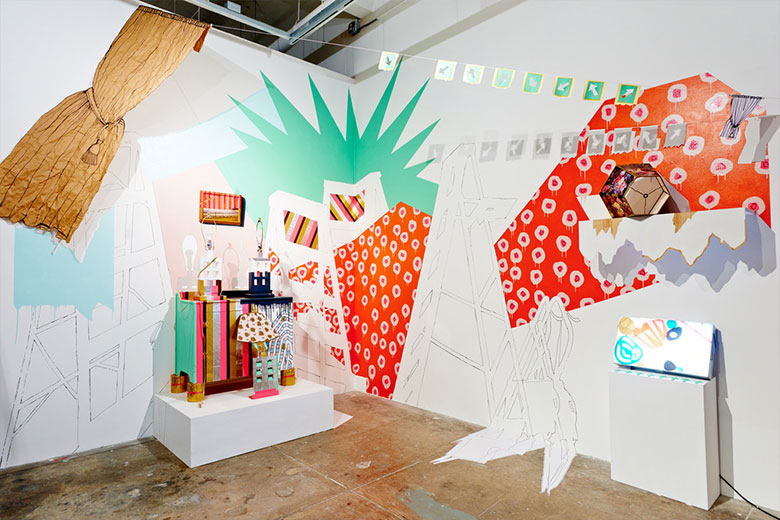 Look-alikes at SOIL Gallery, 2015 – Photography by David Wentworth
Look-alikes at SOIL Gallery, 2015 – Photography by David Wentworth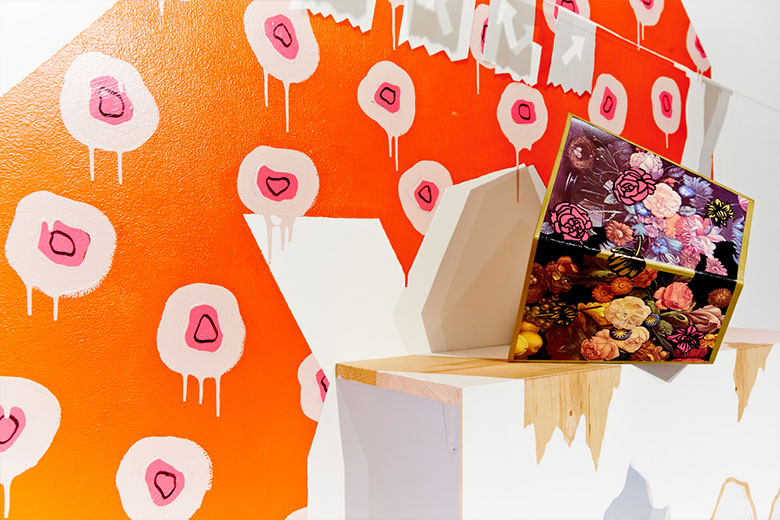
Intentional Instances in Interactivity
The MadArt Studio is a relatively new space that sits in Seattle’s Lake Union neighborhood, smack dab in the heart of recent office and condo developments galore. Located right on Westlake, its windows are massive, and due to the highly visible nature of the space, its artists are expected to actively engage with the public.
When the 2015 Seattle Art Fair invited Alpert to install in the space, she was the third artist to ever be extended the opportunity. She was rightfully intimidated. As though the lack of privacy and the high-profile nature of the show weren’t daunting enough, Alpert was expected to fill a space that measured nearly 54′ x 54′ x 15′ — more than double or triple the size of her usual gallery habitats — and unlike most galleries, the MadArt Studio is a re-purposed car dealership from the 1920s. Outfitted with steel beam constructions, it is housed in plenty of glass and brick, which required Alpert to rethink some of her tried-and-true habits.
“Normally, I’ll make things that extend from the walls, so I had to come up with some pretty quick solutions on how I was going to suspend things,” explains Alpert, who eventually created Backdrop using a large quantity of magnets and paper. “I really wanted to break up the space efficiently… big rolls of paper and tiling together big rolls of butcher paper or clear mylar: that ended up being the best solution.”
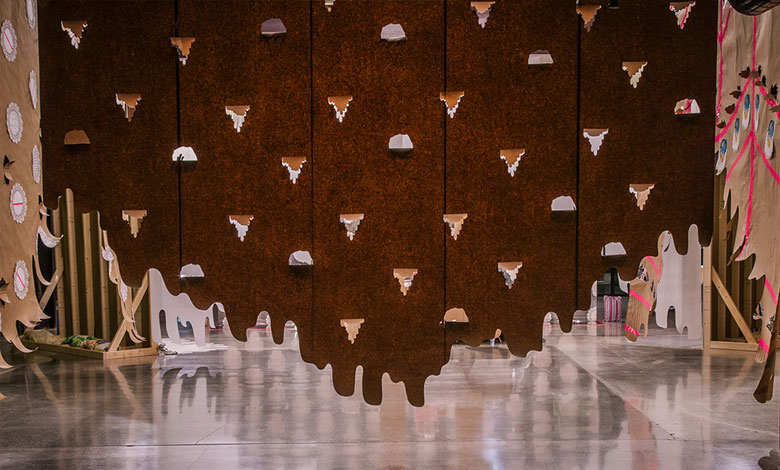 Backdrop at MadArt, 2015 – Photography by James Harnois
Backdrop at MadArt, 2015 – Photography by James Harnois
Alpert emerged from that project stronger and more adaptable than she ever gave herself credit for. It served as affirmation of what Alpert has always known: that she creates her best work when she follows her intuition and trusts her artistic guts, even in the face of confusion.
“In the first week, I felt really tripped up, because I wanted [Backdrop] to work like my previous pieces… but it just wasn’t the same kind of situation or the same kind of space. I kept trying to stick to my drawings, and I kept getting deeper and deeper into this hole of trying to solve problems that I didn’t necessarily need to solve,” Alpert says, as though recanting memories from college. “So I just sort of veered off to the right and said, ‘Fuck it, I’m just going to make what feels right’ — and then it started to flow a lot better.”
That Alpert was invited to work in the unconventional MadArt space is more than appropriate. Too often, art openings are fancy excuses for socializing, where the art itself is more atmospheric background fodder than an engaging experience. Naturally, these works and these openings fade passively from memory. Alpert’s work, by contrast, demands attention. Her willingness to utilize every surface, including the ground, inherently sparks conversation about rigidity and rules within the gallery setting.
“I’m always surprised at how many people step on things and touch things…” says Alpert, who suspects that many who view her work may be unfamiliar with gallery installations. “I don’t think that people know what the etiquette is, and not everybody sees everything. They [may be] looking up at something, but they’re stepping on something else.”
While these interactions make Alpert nervous, she shies away from over-explaining. She notes that some artists purposely create pathways for viewers to travel through, but she believes such restrictions “interfere with the experience”, and instead, has found value in taking a more sociological view.
“I think I’m intentionally putting bright white vinyl on the floor, so that when I come in later, I can kind of see the history of people’s track marks,” she explains.
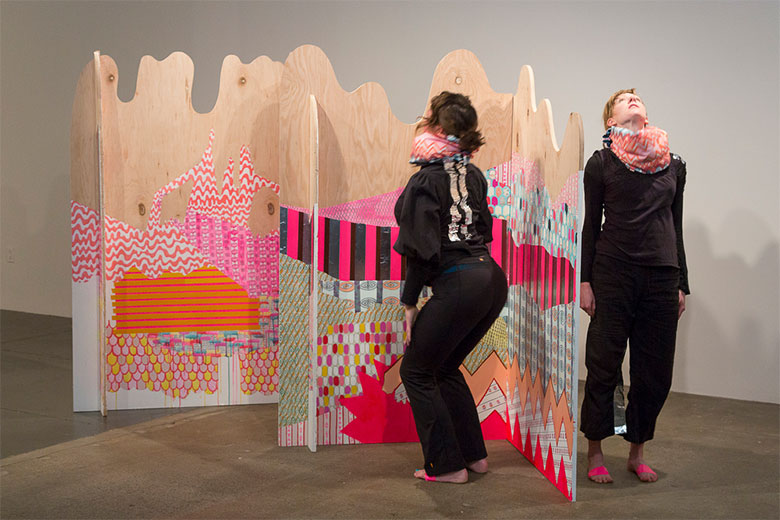 Tableau Vivant at Gallery 4Culture, 2012 – Photography by Steven Miller
Tableau Vivant at Gallery 4Culture, 2012 – Photography by Steven Miller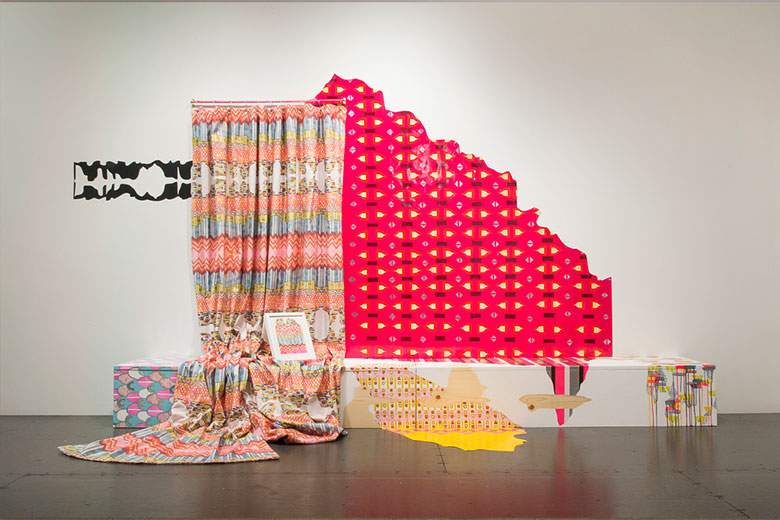
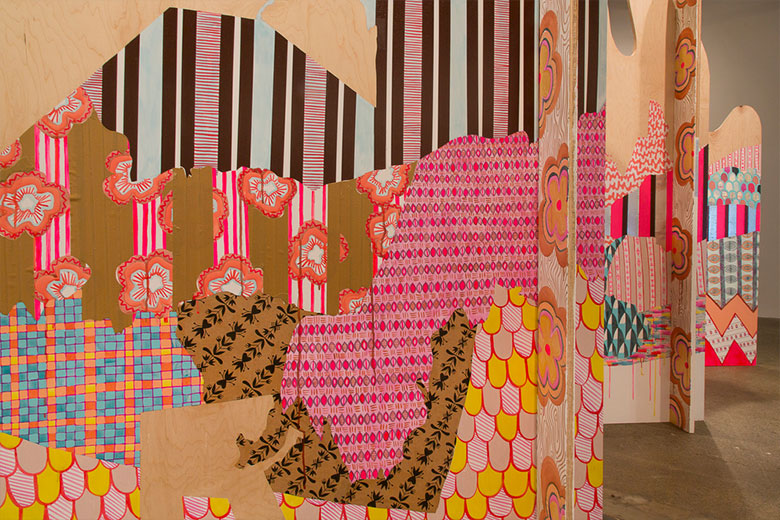
For 2012’s Tableau Vivant, Alpert gave movement artists Shellie Gravitt and Naomi Russell free reign to create an opening night performance for her site-specific installation. It seemed like a slight nod to her background in theatre — and Alpert has expressed an interest in exploring similar projects in the future — but even without dancers, artist-audience interactivity feels central to Alpert’s work. In a recent conversation with Jen Graves, well-known arts writer for Seattle’s weekly rag, The Stranger, Graves inquired, “Are you the director, or are you the performer?” Alpert’s response was that she was probably both. She may not be posting signs or “to-do”‘s, but attempts to guide in more subtle ways.
“It’s kind of like saying, ‘Don’t’ step here; do step here. I know you want to touch that, because the texture looks really exciting to touch, but I don’t want you to touch it,'” Alpert explains. “I am interested in the tension that that creates.”
“But you know, the roles come at different times,” she continues, “so being the performer comes in private, as I’m making the piece, and then once it’s up and people are moving through it, I’m sort of this ghost director.”
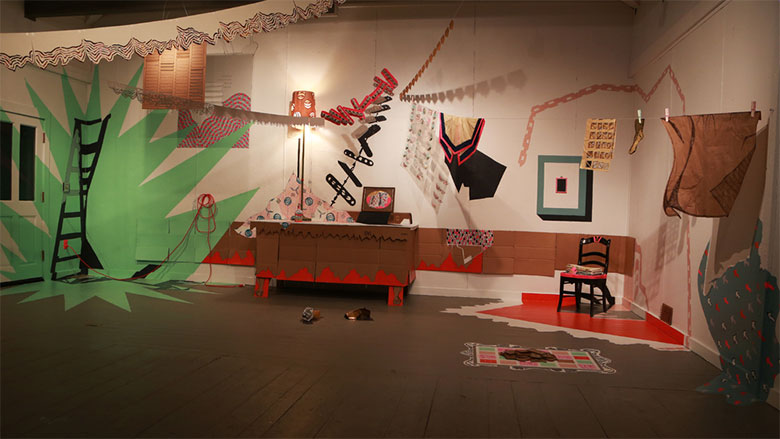 Three Generations of Decorations at The MacDowell Colony, 2014 – Photography by Tom Weidlinger
Three Generations of Decorations at The MacDowell Colony, 2014 – Photography by Tom Weidlinger
Nostalgic Needs Nobody Knew
The concept of nostalgia as illusion parallels the Alice in Wonderland feel of Alpert’s works, which evoke memories at once vaguely familiar and bizarrely otherworldly. To use a phrase borrowed from Bay Area artist Sara Applebaum, the creations allow for a “revelation of the mundane”, wherein the recontextualization of warm color palettes and objects of vintage lore breathes new life into musty, dusty pasts.
“I use a lot of colors and patterns that… have, maybe a little bit of a David Lynch feel to it sometimes. I’m not trying to be campy or ironic,” says Alpert, “but I am definitely trying to reference these somewhat iconic images or things that remind us of certain iconic images from certain time periods.”
The factors which draw Alpert to these images remained a bit of a mystery until Spring 2014, when she had some epiphanies while participating in a residency at The MacDowell Colony in New Hampshire.
“That’s why people go to residencies,” Alpert states matter-of-factly. “[You] have these epiphanies, because you’re spending so much time by yourself, and you’re isolated, and all you can do is think about why you’re doing what you’re doing.”
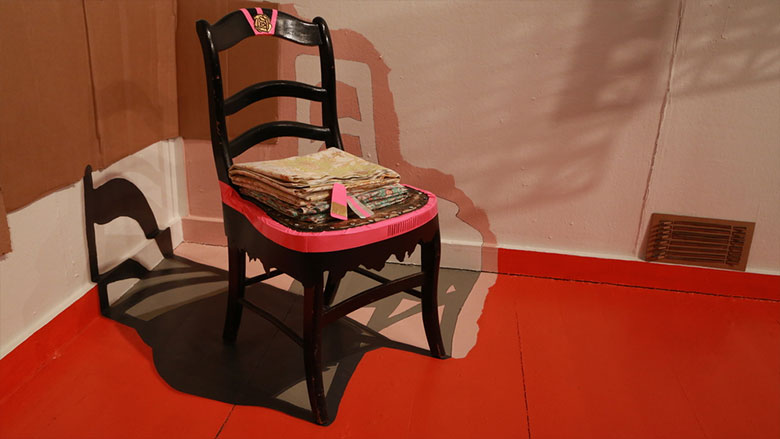
Surrounded by natural beauty, Alpert was given the opportunity to reflect on her very unique bringing, and she realized that her aesthetic is very much informed by her surreal relationship to her grandparents.
“It’s the WWII generation, and each of my sets of grandparents decorated their homes in very different ways,” she recalls. “My dad’s parents were collectors, and they collected everything from very, very high art to objects that they would find at estate sales to furniture. [Their house] was just filled to the brim.”
Within the clutter, Alpert states that there was “no hierarchy of the value of things”; her grandparents would have fine objects, such as Tiffany lamps, positioned side-by-side with knock-off paintings. Everything “worked together in a weird way”, blending into one hell of an influential mish-mash.
By contrast was the home of her other grandparents.
“My mom’s parents were very, very, very frugal, and they would cover their couches with plastic couch covers,” notes Alpert. “There were TV trays that we would eat our boxed and canned food off of. Everything came from a box or a can or a bottle. And they had, in their backyard, one of those big clotheslines that kind of looks like a giant umbrella, that’s on a big pole…”
“I think I’m sort of borrowing from my memory of both of those homes that I spent a lot of time in,” she concludes.
Such logical insights into the past inform Alpert as she moves into the future, with assured confidence in her adaptability as an artist. As she follows her intuitive artistic mind further and further down the rabbit hole, Alpert will continue to manipulate the myriad textures and colors of the free-flowing worlds around her, in ever more dynamic ways.
 Shape Shifters at Cornish College of the Arts, 2013 – Photography by David Wentworth
Shape Shifters at Cornish College of the Arts, 2013 – Photography by David Wentworth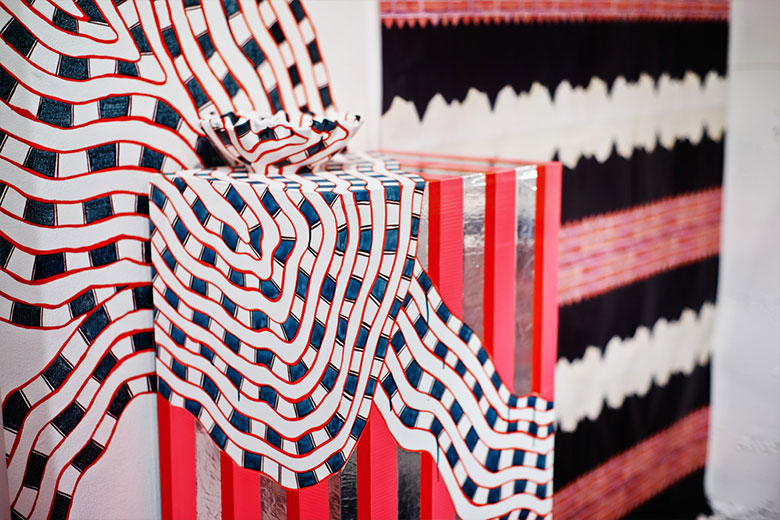
Ω

